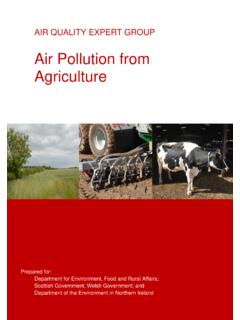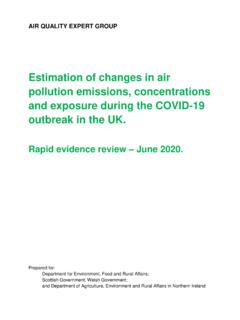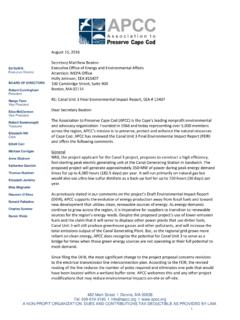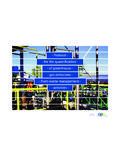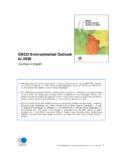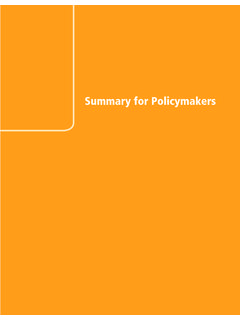Transcription of Climate Change Consequences Of VOC Emission Controls
1 Climate Change Consequences Of VOC Emission Controls AEAT/ENV/R/2475 Report to The Department for Environment, Food and Rural Affairs, Welsh Assembly Government, the Scottish Executive and the Department of the Environment for Northern Ireland ED48749102 Issue 3 September 2007 Title Climate Change Consequences of VOC Emission Controls Customer The Department for Environment, Food and Rural Affairs, Welsh Assembly Government, the Scottish Executive and the Department of the Environment for Northern Ireland Customer reference CSA 7267/AQ03508 Confidentiality, copyright and reproduction This report is the Copyright of AEA Energy & Environment and has been prepared by AEA Energy & Environment under contract to Defra. The contents of this report may not be reproduced in whole or in part, nor passed to any organisation or person without the specific prior written permission of the Commercial Manager, AEA AEA Energy & Environment.
2 AEA Energy & Environment accepts no liability whatsoever to any third party for any loss or damage arising from any interpretation or use of the information contained in this report, or reliance on any views expressed therein. File reference ED48749102 Reference number AEAT/ENV/R/2475 - Issue 3 AEA Energy & Environment The Gemini Building Fermi Avenue Harwell International Business Centre Didcot OX11 0QR t: 0870 190 6539 f: 0870 190 6318 AEA Energy & Environment is a business name of AEA Technology plc AEA Energy & Environment is certificated to ISO9001 and ISO14001 Authors Name Tim Murrells Prof R G Derwent (rdscientific) Approved by Name Signature Date 4th September 2007 Unclassified Climate Change Consequences of VOC Emission control AEAT/ENV/R/2475 AEA Energy & Environment iii Climate Change Consequences of VOC Emission control Unclassified AEAT/ENV/R/2475 iv AEA Energy & Environment Executive summary There are possible Climate Change Consequences of VOC emissions to the atmosphere and from their control by incineration.
3 This report discusses these Consequences and documents a simple methodology for quantifying them based on the Global Warming Potential (GWP) concept. The approach is provided with worked examples for assessing the Climate Change Consequences of VOC Emission control by incineration, based on calculating the CO2 equivalent emissions from direct release of a VOC due to its direct or indirect GWP versus the CO2 equivalent emissions arising from the carbon in the fossil fuel used to aid incineration. In this way, it should be straightforward to see whether, and by how much, VOC incineration could mitigate the Climate Change Consequences of direct VOC Emission to the atmosphere. The report does not consider health or other environmental impacts arising from any by-products of incineration. It has also not considered other, non- Climate Change environmental impacts of unabated VOC emissions and use of less efficient VOC control measures.
4 One of the Consequences of these will be the potential to form ground-level ozone and human health and wider environmental (damage to crops and materials) associated with this. These are issues which were outside the scope of this study. Unclassified Climate Change Consequences of VOC Emission control AEAT/ENV/R/2475 AEA Energy & Environment v Table of contents 1 Introduction 1 2 Climate Change Consequences of VOC emissions 2 3 Calculating Climate Change Consequences of VOC Emission Controls 3 CO2 Equivalent emissions from Direct Release of a VOC 3 CO2 Equivalent emissions from Incineration of a VOC 4 Quantifying the Climate Change Consequences of VOC Incineration Compared with Direct Release 5 Worked Examples 6 4 Summary and Conclusions 13 5 References 15 Annex A Summary of the Solvent emissions Directive 1999/13/EC 16 Annex B Global Warming Potentials (GWPs) of some common VOCs.
5 18 Annex C Fuel CO2 conversion factors for different fuel types 19 Climate Change Consequences of VOC Emission control Unclassified AEAT/ENV/R/2475 vi AEA Energy & Environment Unclassified Climate Change Consequences of VOC Emission control AEAT/ENV/R/2475 AEA Energy & Environment 1 1 Introduction Because of concerns over ground-level ozone formation and regional air quality, the Commission of the European Communities has promulgated a directive dealing with solvent emissions , the Solvents emissions Directive, SED (OJ, 1999). As a consequence, industry is required to reduce its emissions of volatile organic compounds (VOCs) in general, and solvents in particular. Because solvents are important ozone precursors, the SED will help to reduce ozone formation and meet future air quality targets. Annex A provides a brief summary of what the SED covers.
6 The choice of optimal VOC Emission control measure is highly dependent on the nature of the specific solvent-using process and is highly solvent-specific. One potential VOC Emission control measure is incineration. Industry may well question the wisdom of incineration because of the apparent conflict between the Climate Change Consequences of increased fuel usage by the incineration equipment and the requirements of the SED to reduce photochemical ozone formation. However, there may be Climate Change Consequences of the uncontrolled Emission of the solvent. The question is whether the Climate Change penalty of incineration outweighs the Climate Change benefit from controlling the solvent Emission . The ground-level ozone benefits of VOC Emission Controls are taken for granted within the SED. This report addresses the Climate Change Consequences of incineration as a potential abatement option for controlling VOC emissions and provides a simple means for quantitatively assessing the CO2 equivalent emissions of incineration versus direct release of the VOC taking into account the VOC s direct global warming potential and the use of any supplementary fuel from fossil fuel feedstocks required to aid incineration.
7 The benefits, or otherwise, of incineration as a means of disposing of VOCs that would otherwise be released to air are only considered in the context of Climate Change . Other environmental effects of VOC emissions and their incineration are outside the scope of this report. Other means of controlling VOC emissions , besides incineration, are also outside the scope of the report. Climate Change Consequences of VOC Emission control Unclassified AEAT/ENV/R/2475 2 AEA Energy & Environment 2 Climate Change Consequences of VOC emissions Global warming, Climate Change and the greenhouse effect, however it is termed, are all driven by processes that interfere with the earth s radiation budget. The earth absorbs energy in the form of ultraviolet, visible and infrared radiation from the sun and emits infrared radiation to outer space.
8 These two processes are always in balance. Certain atmospheric trace gases, the radiatively-active trace gases, absorb some of the outgoing infrared radiation and so disturb this radiative balance. The earth s surface and atmosphere react to this disturbance by warming and so re-establish the radiative balance. This process is called radiative forcing and the warming is the greenhouse effect. The most important radiatively-active trace gases in the atmosphere are water vapour and carbon dioxide. Their presence accounts for the natural greenhouse effect that is estimated to be about 30oC. Our concern here, is with man-made trace gases, some of which act as potent greenhouse gases, that have acted to produce a man-made greenhouse effect with its Climate Change Consequences . It is convenient to measure this potency using the global warming potential GWP index.
9 The GWP of a trace gas is the ratio of the radiative forcing from a given mass Emission of the trace gas compared to that from the same mass Emission of carbon dioxide, integrated over a given time horizon. Simply stated, the GWP of a VOC is a measure of its Climate Change impact relative to carbon dioxide. The GWP of a trace gas depends on its infrared absorption spectrum and whether this overlaps significantly with the wavelength distribution of the outgoing infrared radiation emitted by the earth. It also depends on how long the trace gas remains in the atmosphere once emitted. Methane and halocarbons are important greenhouse gases not only because they have strong infrared absorption bands in the atmospherically-relevant region but also because they are long-lived in the atmosphere. GWPs are calculated by complex global Climate models over different time-integrated periods.
10 The time-integration period is important because the radiative forcing effect of a trace gas relative to carbon dioxide depends on the time period it is integrated over because of the dynamic and evolving Climate system. Annex B presents the GWP indices for a number of VOCs compiled from available information on infrared absorption spectra and atmospheric lifetimes and integrated over a 100 year time horizon. A species with a GWP of 10 means that emitting 1 tonne of the species has the same Climate Change Consequences as emitting 10 tonnes of CO2 over a 100 year time span. For the halocarbons, these refer to direct GWPs , that is to say, they refer to warming effects directly caused by the long lifetime and infrared absorption properties of the species themselves. However, the chlorinated HCFCs have an indirect, negative global warming effect as a consequence of the depletion of stratospheric ozone caused by the release of the chlorine during the slow degradation of the HCFCs in the atmosphere.
